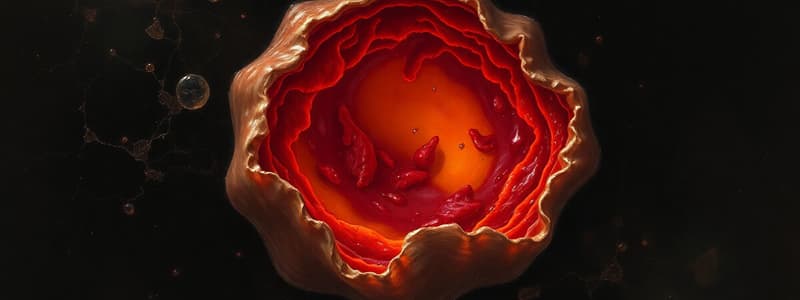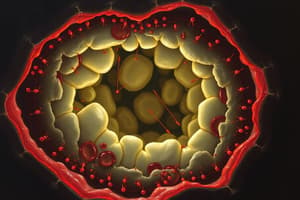Podcast
Questions and Answers
Which of the following correctly describes the primary function of an endocrine gland?
Which of the following correctly describes the primary function of an endocrine gland?
- To produce electrical impulses for quick responses
- To transmit signals across a synapse to neighboring cells
- To release hormones directly into the bloodstream (correct)
- To secrete digestive enzymes into the gastrointestinal tract
What distinguishes a hormone from a neurotransmitter?
What distinguishes a hormone from a neurotransmitter?
- Hormones have a fast action and short duration, while neurotransmitters have delayed onset
- Hormones act on adjacent cells, while neurotransmitters act on distant targets
- Hormones operate only within the CNS, while neurotransmitters function outside the CNS
- Hormones are released by glands, while neurotransmitters are released by neuronal cells (correct)
Which of the following glands is classified as a central endocrine gland?
Which of the following glands is classified as a central endocrine gland?
- Parathyroid gland
- Thyroid gland
- Adrenal glands
- Pituitary gland (correct)
What role do neurohormonal cells play in the endocrine system?
What role do neurohormonal cells play in the endocrine system?
What is the expected result of a hormone binding to its receptor?
What is the expected result of a hormone binding to its receptor?
What distinguishes cell necrosis from cell apoptosis?
What distinguishes cell necrosis from cell apoptosis?
Which of the following triggers cell apoptosis?
Which of the following triggers cell apoptosis?
In a case of metabolic acidosis, which of the following laboratory findings would you expect?
In a case of metabolic acidosis, which of the following laboratory findings would you expect?
What physical appearance indicates cell apoptosis compared to cell necrosis?
What physical appearance indicates cell apoptosis compared to cell necrosis?
What is the pH level associated with respiratory acidosis?
What is the pH level associated with respiratory acidosis?
Which statement is associated with metabolic acidosis?
Which statement is associated with metabolic acidosis?
What characterizes the primary acid-base disturbance in the case presented?
What characterizes the primary acid-base disturbance in the case presented?
What type of feedback mechanism primarily controls most homeostatic systems in the body?
What type of feedback mechanism primarily controls most homeostatic systems in the body?
What is the primary purpose of cerebrospinal fluid (CSF)?
What is the primary purpose of cerebrospinal fluid (CSF)?
Where is cerebrospinal fluid (CSF) primarily produced?
Where is cerebrospinal fluid (CSF) primarily produced?
What is a key difference in sodium ion (Na+) concentration between CSF and plasma?
What is a key difference in sodium ion (Na+) concentration between CSF and plasma?
Which component is present in a higher concentration in cerebrospinal fluid (CSF) compared to plasma?
Which component is present in a higher concentration in cerebrospinal fluid (CSF) compared to plasma?
What structure is essential for the selective permeability of the Blood-Brain Barrier (BBB)?
What structure is essential for the selective permeability of the Blood-Brain Barrier (BBB)?
What is the primary function of brain extracellular fluid (BECF)?
What is the primary function of brain extracellular fluid (BECF)?
Which statement reflects a similarity between cerebrospinal fluid (CSF) and plasma?
Which statement reflects a similarity between cerebrospinal fluid (CSF) and plasma?
What happens to the likelihood of action potentials (AP) when there is a lower concentration of Na+ in CSF?
What happens to the likelihood of action potentials (AP) when there is a lower concentration of Na+ in CSF?
What is the primary function of aldosterone?
What is the primary function of aldosterone?
What is the primary effect of binding a hormone to its specific receptor on a target cell?
What is the primary effect of binding a hormone to its specific receptor on a target cell?
Which of the following is produced by the zona fasciculata?
Which of the following is produced by the zona fasciculata?
What is the primary regulatory mechanism for glucocorticoid release?
What is the primary regulatory mechanism for glucocorticoid release?
Which of the following describes the storage characteristics of water-soluble hormones?
Which of the following describes the storage characteristics of water-soluble hormones?
Where are mineralocorticoids specifically synthesized in the adrenal cortex?
Where are mineralocorticoids specifically synthesized in the adrenal cortex?
Which statement best describes lipid-soluble hormones compared to water-soluble hormones?
Which statement best describes lipid-soluble hormones compared to water-soluble hormones?
What triggers the release of renin from the kidneys?
What triggers the release of renin from the kidneys?
Which intracellular effect is NOT associated with hormone action?
Which intracellular effect is NOT associated with hormone action?
What is the primary source of synthesis for steroid hormones?
What is the primary source of synthesis for steroid hormones?
Which hormones are classified as glucocorticoids?
Which hormones are classified as glucocorticoids?
What is the main physiological effect of cortisol?
What is the main physiological effect of cortisol?
Which category of hormones is classified as water-soluble?
Which category of hormones is classified as water-soluble?
What mechanism do water-soluble hormones primarily use to interact with target cells?
What mechanism do water-soluble hormones primarily use to interact with target cells?
In which layer of the adrenal cortex are sex hormones produced?
In which layer of the adrenal cortex are sex hormones produced?
What characteristic distinguishes the transport of water-soluble hormones from that of lipid-soluble hormones?
What characteristic distinguishes the transport of water-soluble hormones from that of lipid-soluble hormones?
Flashcards are hidden until you start studying
Study Notes
Cell Death Mechanisms
- Cell Necrosis: Unintentional cell death characterized by swelling and rupture.
- Cell Apoptosis: Programmed cell death that leads to cell shrinkage and implosion with specific triggers including viral infections, DNA damage, membrane/mitochondrial damage, endoplasmic reticulum stress, and immune cell induction.
- Both processes serve as forms of cell death essential in various physiological and pathological contexts.
Case Study - Acid-Base Disturbances
- A 66-year-old male with diabetes and COPD exhibits diarrhea, fatigue, and hypotension upon emergency department visit.
- Laboratory findings show a metabolic acidosis with low HCO3 and elevated BUN and creatinine, indicating kidney impairment.
- ABG results indicate a pH of 7.22 and a PaCO2 of 52 mm Hg, confirming concurrent respiratory acidosis due to hypoventilation.
Homeostatic Feedback Systems
- Homeostatic feedback systems utilize negative feedback loops to maintain biological parameters within an optimal range.
- Example: Circulation of cerebrospinal fluid (CSF) is crucial for regulating intracranial pressure and providing physical protection for the brain.
- Control systems for these feedback mechanisms predominantly include the nervous and endocrine systems.
Cerebrospinal Fluid (CSF) vs. Plasma
- CSF exhibits lower concentrations of Na+ and K+, leading to decreased neuronal excitability and reduced action potential thresholds, which aids in preventing seizures.
- CSF contains higher Mg2+ levels, which help reduce neuronal membrane permeability and firing.
- Amino acids and proteins, found less in CSF, act as neurotransmitters crucial for signaling.
Blood-Brain Barrier (BBB)
- The BBB is a selective permeability barrier that separates circulating blood from brain extracellular fluid, essential for maintaining central nervous system homeostasis.
- Comprises tightly packed endothelial cells, astrocytes, and pericytes that regulate substance passage.
Hormones vs. Neurotransmitters
- Hormones are chemical messengers released into the bloodstream, acting on distant targets with delayed, prolonged effects.
- Neurotransmitters are short-range signaling molecules released at synapses, facilitating rapid, immediate communication between adjacent cells.
Hormone-Receptor Relationship
- Hormones bind to specific receptors on target cells, activating intracellular cascades that can alter ion channel permeability, modify enzyme activity, or regulate gene expression.
- Effects can lead to significant physiological changes crucial for maintaining homeostasis.
Water-Soluble vs. Lipid-Soluble Hormones
- Water-soluble hormones include peptides, proteins, and amino acid-derived hormones, stored in vesicles and transported freely in plasma.
- Lipid-soluble hormones, such as steroids, are synthesized from cholesterol, often not stored, and transported bound to plasma proteins.
Categories of Hormones
- Water-soluble hormones: Peptides and amino acid-derived.
- Lipid-soluble hormones: Steroids and thyroid hormones.
Mineralocorticoids vs. Glucocorticoids
- Mineralocorticoids: Synthesized in the adrenal cortex (zona glomerulosa), regulate blood pressure and fluid balance primarily through aldosterone.
- Glucocorticoids: Produced in the adrenal cortex (zona fasciculata), regulated by stress with cortisol as the primary hormone, influencing glucose metabolism.
Physiological Effects of Cortisol
- Increases blood glucose levels, enhances fat and protein metabolism, and suppresses immune function.
- Follows a diurnal pattern, with levels peaking in the morning and declining throughout the day.
Studying That Suits You
Use AI to generate personalized quizzes and flashcards to suit your learning preferences.



